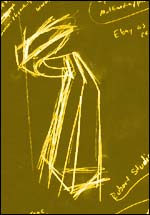|
|
 |
|
|
| |


|
|
Structure is very important to artist
Russ RuBert. It is the research, design, and framework
on which he builds, and it enables him to create
large fanciful sculptures that are in some ways
like giant toys, pushing the boundaries of what
people expect of art, pushing them to try something
unexpected.
And yet these are not just sculptures for children,
but for the child in all of us—for the child-like
wonder that needs to be awakened so that we too
can play with a fantastic robot or touch a cloud.
|
"Fusionism...I like
to take ideas, art, and concepts from other
cultures, other artists, other times in
history and merge them all together."
|
One reason that his sculptures seems able to bridge
all ages of people is something that RuBert calls
"Fusionism...I like to take ideas, art, and
concepts from other cultures, other artists, other
times in history and merge them all together."
This is obvious in the way that RuBert incorporates
a wide variety of materials and technology into
his work. Like an architect who uses diverse building
materials to create a rich environment, RuBert chooses
different materials to create a complete concept.
In his kinetic pieces, even the smallest details
are well designed by the artist.
If a sculpture has a fantastic curve that cantilevers
in wild directions, the internal structure may be
completely hidden. If the sculpture is a complex
machine, the internal mechanics may be framed in
a clear plastic box so the viewer can see them work.
To make his sculptures work, RuBert is almost fanatical
about testing, designing and engineering his pieces
which may incorporate electricity, neon, or kinetics.
In his passion to design large metal forms with
complex balance points and multiple components,
he has developed his own 3D CAD/CAM computer systems.
These computers allow him to create scaled models
and design structural systems that rival the capabilities
of the most advanced architectural companies.
Once a sculpture is under construction in the studio,
the work becomes very hands-on. For this RuBert
is well-equipped with a 22,000 square foot industrial
studio that has dedicated metal-working areas, finishing
rooms, and a even its own sixty-foot tall crane.
Beyond working, these sculptures are beautiful!
Although stainless steel is one of the hardest metals
to work, the end result is not cold or overly industrial.
Forms of stainless steel move in organic curves,
covered with sweeping, swirling patterns that sometimes
follow the form, sometimes contrast it.
RuBert puts these patterns into his metal surfaces
like brush strokes, except that these brush strokes
are made with a fifteen-pound abrasive tool and
reflect light that moves as the viewer does.
| ...he muses
that when a sculpture is getting so complicated
that he can no longer draw it on paper, "that's
when I know that it is starting to get really
good." |
It is his sensitivity to form and scale combined
with a touch of whimsy that takes what RuBert calls
fusionism far beyond assemblage art. Diverse materials
and ideas are more than bolted together, they are
assimilated and reincarnated into something totally
new.
RuBert travels extensively, seeking out architecture
and art of other cultures. He is well-read in environmental
and natural sciences. He also has over twenty years
experience designing and building computer systems.
These diverse influences add depth and complexity
to his work.
Discovering the ability to think in three dimensions
was a pivotal point in his life. RuBert recalls
the day when he was six years old that he first
visualized a solid object clearly in his mind, and
he has continued to develop this ability his whole
life. Although he uses computers extensively in
his design process, the concept always starts in
his imagination and "in his heart."
In fact, he muses that when a sculpture is getting
so complicated that he can no longer draw it on
paper, "that's when I know that it is starting
to get really good." The complex three-dimensional
forms that RuBert creates are sometimes difficult
to photograph. Reflections of light move across
complex surfaces. What looks like a straight line
on one side may actually be a curved or twisted
form. To fully experience a sculpture that may also
incorporate movement or sound, the viewer needs
to experience it in real life.
Intrinsic to his work is his belief that art should
activate an area and excite and inspire the viewer's
imagination. To achieve such ambitious goals, RuBert
will draw on any of his vast arsenal of tools, skills,
and experience to create the unexpected. |
|
| |
|
|
|
|
All rights reserved | © rubert.com
1980 - 2005
|
|